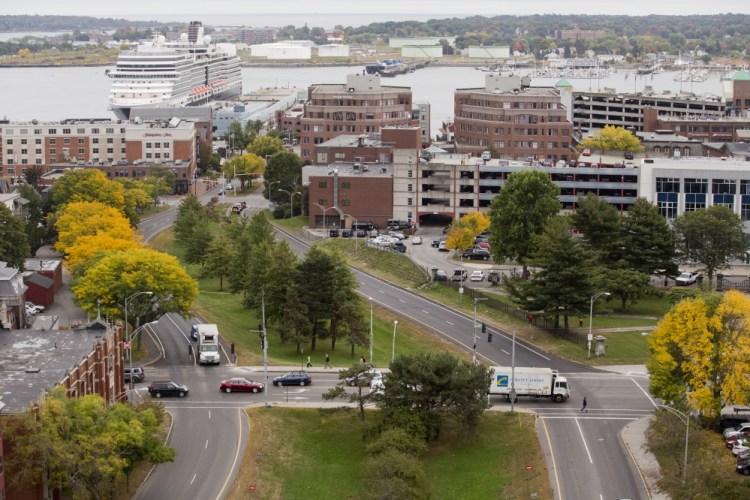The Portland City Council voted unanimously Monday night to approve a master plan to redesign Franklin Street – a major thoroughfare that some residents say is unfriendly to pedestrians and has severed the east side of the city from the vibrant downtown.
The project, which has been in the planning stages for at least two years, is estimated to cost $34.5 million. The council action will allow more detailed plans to be drafted for the multiphased project, but construction is not expected to begin until federal funding becomes available.
Although some councilors expressed concerns over the cost, Councilor David Marshall said the council was just endorsing a design, not allocating funding. The city’s share of the cost could be as low as $5 million, if federal grants become available.
“The decision tonight is on a planning document,” Marshall said. “We’re not talking about pitting this against a school. We’re not talking about other projects going forward.”
The recommendations include maintaining four lanes of traffic, but the grassy median would be eliminated, which is expected to open up land on each side of the road to development.
The plan envisions a roundabout at the intersection of Franklin and Commercial streets. Lincoln Park would be expanded and 5-foot bicycle lanes would be added to both sides.
The 100-foot-wide medians stretching almost the entire length of Franklin Street would be reduced to between 5 and 10 feet.
According to a memo to the council from city staff, $8 million of the project’s estimated cost would be for a needed separation of sewer and stormwater lines.
Councilor David Brenerman spoke against the project, saying narrowing Franklin Street “makes no sense to me.” The city is currently having difficulty prioritizing other, more pressing capital needs, including renovating schools, he said.
“Franklin Street doesn’t fit (city priorities),” said Brenerman, who nevertheless ultimately supported the plan.
The plan had some skeptics, but most people spoke in support of the redesign during a public hearing.
Jamie Parker of Portland Trails said the project would be expensive but could pay for itself, since a more pedestrian-friendly road would foster economic development.
Roads are “the lifeblood of the community,” Parker said. “People are what creates a great city, not the cars that bring them.”
The Franklin Street arterial was built as part of the urban renewal movement in the late 1960s. Entire neighborhoods, mostly of immigrant families, were uprooted and the entire India Street neighborhood was severed from Portland’s downtown to create a major thoroughfare to move traffic into and out of the city.
Franklin Street now is a heavily traveled corridor that moves traffic off Interstate 295 and into Portland. More than 20,000 vehicles a day use the street.
Peaks Island resident Arthur Fink called it “one of the biggest mistakes in the history of Portland,” one that the city has the opportunity to correct by adopting the master plan.
However, Brent Noyes opposed the master plan, because it would result in the loss of a parking lot used by his family’s self-storage and moving businesses, which has been in Portland for more than 85 years.
Noyes said the parking lot would be used to provide vehicle access at Oxford street. That recommendation comes from city staff, not an advisory group, which contemplated only pedestrian and bike access.
“I just think you’re going down a bad path by including this in your recommendation,” Noyes said. “It sets a terrible precedent” to take private property.
Randy Billings can be contacted at 791-6346 or at:
rbillings@pressherald.com
Twitter: @randybillings
Send questions/comments to the editors.





Comments are no longer available on this story